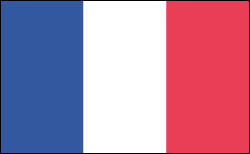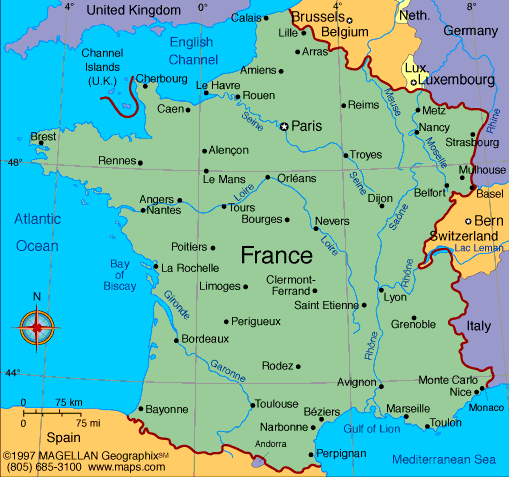FRANCE

Geography: France is about 80% the size of Texas. In the Alps near the Italian and Swiss borders is western Europe's highest point—Mont Blanc (15,781 ft; 4,810 m). The forest-covered Vosges Mountains are in the northeast, and the Pyrénées are along the Spanish border. Except for extreme northern France, the country may be described as four river basins and a plateau. Three of the streams flow west—the Seine into the English Channel, the Loire into the Atlantic, and the Garonne into the Bay of Biscay. The Rhône flows south into the Mediterranean. For about 100 mi (161 km), the Rhine is France's eastern border. In the Mediterranean, about 115 mi (185 km) east-southeast of Nice, is the island of Corsica (3,367 sq mi; 8,721 sq km).
Government: Fifth republic.
History: Archeological excavations indicate that France has been continuously settled since Paleolithic times. The Celts, who were later called Gauls by the Romans, migrated from the Rhine valley into what is now France. In about 600 B.C. , Greeks and Phoenicians established settlements along the Mediterranean, most notably at Marseille. Julius Caesar conquered part of Gaul in 57–52 B.C. , and it remained Roman until Franks invaded in the 5th century A.D.
The Treaty of Verdun (843) divided the territories corresponding roughly to France, Germany, and Italy among the three grandsons of Charlemagne. Charles the Bald inherited Francia Occidentalis, which became an increasingly feudalized kingdom. By 987, the crown passed to Hugh Capet, a princeling who controlled only the Ile-de-France, the region surrounding Paris. For 350 years, an unbroken Capetian line added to its domain and consolidated royal authority until the accession in 1328 of Philip VI, first of the Valois line. France was then the most powerful nation in Europe, with a population of 15 million.
Government: Fifth republic.
History: Archeological excavations indicate that France has been continuously settled since Paleolithic times. The Celts, who were later called Gauls by the Romans, migrated from the Rhine valley into what is now France. In about 600 B.C. , Greeks and Phoenicians established settlements along the Mediterranean, most notably at Marseille. Julius Caesar conquered part of Gaul in 57–52 B.C. , and it remained Roman until Franks invaded in the 5th century A.D.
The Treaty of Verdun (843) divided the territories corresponding roughly to France, Germany, and Italy among the three grandsons of Charlemagne. Charles the Bald inherited Francia Occidentalis, which became an increasingly feudalized kingdom. By 987, the crown passed to Hugh Capet, a princeling who controlled only the Ile-de-France, the region surrounding Paris. For 350 years, an unbroken Capetian line added to its domain and consolidated royal authority until the accession in 1328 of Philip VI, first of the Valois line. France was then the most powerful nation in Europe, with a population of 15 million.

Map of France
President: François Hollande (2012)
Prime Minister: Manuel Valls (2014)
Land area: 210,668 sq mi (545,630 sq km);
total area: 211,209 sq mi (547,030 sq km)
Population (2014 est.): 66,259,012 (growth
rate: 0.45%); birth rate: 12.49/1000; infant mortality rate: 3.31/1000;
life expectancy: 81.66
Capital and largest city (2014 est.):
Paris, 10.764 (metro. area)
Other large cities:
Lyon 1.597 million; Marseille-Aix-en-Provence 1.595 million;
Lille 1.025 million; Nice-Cannes 961,000; Toulouse 926,000 (2014)
Monetary unit: Euro (formerly French
franc)
National
name: République Française
Languages:
French (official) 100%, rapidly declining regional
dialects and languages (Provencal, Breton, Alsatian, Corsican, Catalan,
Basque, Flemish)
Ethnicity/race:
Celtic and Latin with Teutonic, Slavic, North
African, Southeast Asian, and Basque minorities
Religions:
Christian (overwhelmingly Roman Catholic) 63-66%, Muslim 7-9%, Jewish .5-.75%, Buddhist .5-.75%, other .5-1.0%, none 23-28%
National Holiday:
Fete de la Federation, July 14
Literacy rate: 99% (2011 est.)
Economic summary: GDP/PPP (2014 est.):
$2.902 trillion; per capita $40,400. Real growth rate: 0.4%.
Inflation: 0.7%. Unemployment: 9.7%. Arable land:
33.45%. Agriculture: wheat, cereals, sugar beets, potatoes, wine
grapes; beef, dairy products; fish. Labor force: 29.87 million;
services 76.4%, industry 20.6%, agriculture 2.9% (2012).
Industries: machinery, chemicals, automobiles, metallurgy,
aircraft, electronics; textiles, food processing; tourism. Natural
resources: coal, iron ore, bauxite, zinc, uranium, antimony,
arsenic, potash, feldspar, fluorospar, gypsum, timber, fish.
Exports: $578.3 billion (2014 est.): machinery and
transportation equipment, aircraft, plastics, chemicals,
pharmaceutical products, iron and steel, beverages. Imports:
$634 billion (2014 est.): machinery and equipment, vehicles,
crude oil, aircraft, plastics, chemicals. Major trading
partners: Germany, Spain, UK, Italy, Belgium, U.S., Netherlands
(2013).
Communications: Telephones:
main lines in use: 39.29 million (2012); mobile cellular: 62.28
million (2012). Broadcast media: a mix of both
publicly operated and privately owned TV stations; state-owned France
Televisions operates 4 networks, one of which is a network of regional
stations, and has part-interest in several thematic cable/satellite
channels and international channels; a large number of privately owned
regional and local TV stations; multi-channel satellite and cable
services provide a large number of channels; public broadcaster Radio
France operates 7 national networks, a series of regional networks, and
operates services for overseas territories and foreign audiences; Radio
France Internationale (RFI), under the Ministry of Foreign Affairs, is a
leading international broadcaster; a large number of commercial FM
stations, with many of them consolidating into commercial networks
(2008). Television broadcast stations: 584 (plus
9,676 repeaters). Internet hosts: 17.266 million (2012).
Internet users: 45.26 million (2009).
Transportation: Railways: total: 29,640 km
(2011). Roadways: total: 1,028,446 km; paved: paved: 951,220 km
(including 10,490 km of expressways); unpaved: 0 km (2011).
Waterways: 8,500 km (1,686 km accessible to craft of 3,000
metric tons) (2011). Ports and harbors: Bordeaux, Calais,
Dunkerque, La Pallice, Le Havre, Marseille, Nantes, Paris, Rouen,
Strasbourg. Airports: 464 (2013 est.).
International disputes: Madagascar
claims the French territories of Bassas da India, Europa Island,
Glorioso Islands, and Juan de Nova Island; Comoros claims Mayotte;
Mauritius claims Tromelin Island; territorial dispute between Suriname
and the French overseas department of French Guiana; France asserts a
territorial claim in Antarctica (Adelie Land); France and Vanuatu claim
Matthew and Hunter Islands, east of New Caledonia.
-------------------- o --------------------
No comments:
Post a Comment